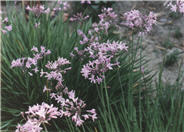
Common name:Society Garlic
Botanical name:Tulbaghia violacea
This clumping perennial will grow less than 1' tall and has narrow, blue-green leaves. Clusters of lavender flowers bloom in spring and summer. Leaves and flowers have a distinct onion or garlic smell if crushed.
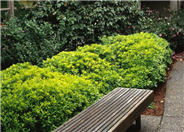
Common name:Wheeler's Dwarf Pittosporum
Botanical name:Pittosporum tobira 'Wheeler's Dwarf'
This handsome dwarf form of the Pittosporum tobira grows into a low, dense mound, 2'-3' tall and 4'-5' wide. This shrub is covered with glossy, evergreen foliage. Small, fragrant, white flowers cover this shrub in spring. It prefers full to part sun and is drought tolerant once its established. Give extra water in summer. Wheeler's Dwarf is dependable and easy to grow. Prune in winter to keep shape.
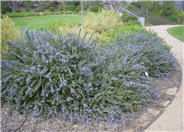
Common name:Prostrate Rosemary
Botanical name:Rosmarinus officinalis 'Prostratus'
The 'Prostratus' grows to a height of 2'-3' with a spread to 8'. Its flowers are pale, lavender-blue in color, and the leaves are needle-like with a dark, blue-green color. This plant makes a good ground cover, and its leaves can be used as seasoning in cooking.
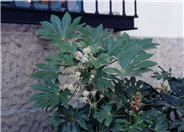
Common name:Japanese Fatsia
Botanical name:Fatsia japonica
This evergreen shrub has large, glossy, fan-like leaves that grow to 16" wide. It has a moderate growth rate to a size of 5'-8' that can be kept lower with occasional pruning. It has a very lush, tropical appearance, and grows well in partial shade.
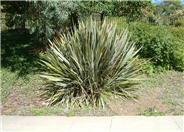
Common name:New Zealand Flax
Botanical name:Phormium tenax
New Zealand Flax is a large, bold plant with stiffly vertical, sword-like, green leaves that arise from its base. It should be grown under full sun for best color. Varieties will offer different growth habits and leaf color.
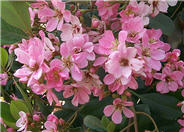
Common name:Rhaphiolepis Pink Lady
Botanical name:Rhaphiolepis indica 'Pink Lady'
This slow-growing plant will only grow 4'-5' high and has dark green, thick foliage. It produces clusters of pink flowers that bloom in spring and clusters of black fruit in the fall. 'Pink Lady' is a vigorous grower to 4'-5' tall and 4'-6' wide, a size which can easily be kept smaller with occasional pruning.
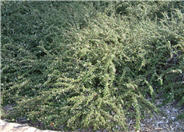
Common name:Pyrenees Cotoneaster
Botanical name:Cotoneaster congestus 'Likiang'
This slow growing Cotoneaster grows to about 3' tall and equally as wide and has downward-curving branches and dark green spiny foliage with the lighter undersides. Pink flowers appear in spring, followed by small red berries. This is a great ground cover around rocks and makes a good bonsai plant. This shrub does better in full sun for flower and fruit production. It is drought tolerant once it's established.
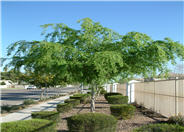
Common name:Chinese Elm, Chinese Evergreen Elm
Botanical name:Ulmus parvifolia
Chinese Elm quickly reaches 50' tall and 60' wide with an upright habit and spreading pendulous branches with age. Chinese Elm has small, dark green leaves. Foliage turns yellow or orange in fall. Small, greenish yellow flower appear in summer but are considered insignificant. Small light brown fruit appear in fall but are not noticeable. Bark is brown gray but with maturity, exfoliates to reveal orange patterns.
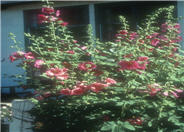
Common name:Hollyhock
Botanical name:Alcea rosea
This plant grows 4-8' high and is particularly useful for background screening. It grows best in full sun in deep, rich, well drained soils and can produce a variety of colors of flowers.
| Designer: | Waves of Green |
Photographer: GardenSoft |
Soils and Compost:
Maintain a two to four inch layer of mulch on the soil surface to reduce weeds, infiltrate rain water, and reduce compaction.
Water Saving Tip:
Change spray sprinklers to low-flow bubbler or drip systems. Shrubs and trees are ideal candidates for this type of irrigation because the water is applied directly to the root zones.
Integrated Pest Management:
Drip and other smart irrigation delivers water directly to roots, allowing no excess water for weeds.
